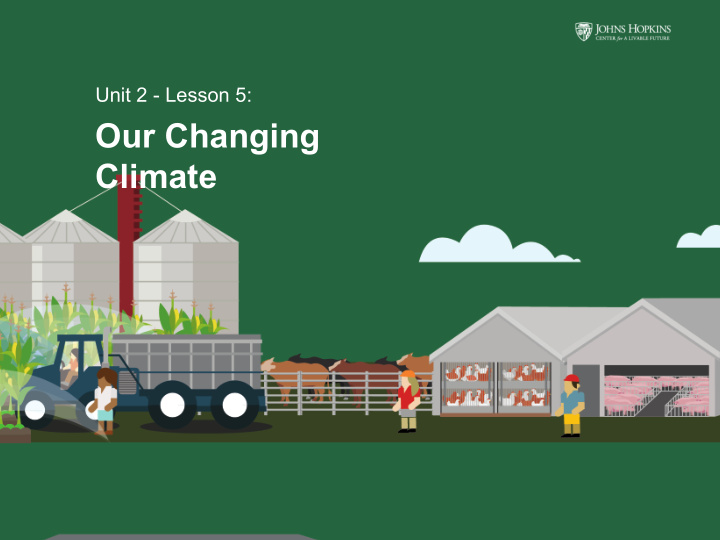



Unit 2 - Lesson 5: Our Changing Climate Unit 2 - Lesson 5: Our Changing Climate // P. 1 Unit 2 - Lesson 5: Our Changing Climate // P. 1
The temperature in New York City Weather averaged 82 degrees Fahrenheit on vs. July 20, 2010. Climate The temperature in New York City averaged 77 degrees Fahrenheit for the month of July between 1981 and 2010. Unit 2 - Lesson 5: Our Changing Climate // P. 2 Unit 2 - Lesson 5: Our Changing Climate // P. 2
Adapted from: "The Greenhouse Effect." US EPA (December 2012), Climate Change Indicators in the United States, 2nd edition, Washington, DC, USA: US EPA, http://www.epa.gov/climatechange/science/indicators/download.html, p.3. EPA 430-R-12-004. ¡ Unit 2 - Lesson 5: Our Changing Climate // P. 3 Unit 2 - Lesson 5: Our Changing Climate // P. 3
Sources of Greenhouse Gases Decomposition of food waste in landfills Methane Use of nitrogen-based fertilizer on crops Nitrous oxide Transporting food products Carbon dioxide, nitrous oxide & Bacterial decomposition in rice paddies methane Livestock waste left on fields Methane Clearing forests for farmland Methane & nitrous oxide Digestion of organic material by livestock Carbon dioxide Running agricultural machinery Methane & nitrous oxide Carbon dioxide, nitrous oxide & methane Unit 2 - Lesson 5: Our Changing Climate // P. 4 Unit 2 - Lesson 5: Our Changing Climate // P. 4
Photo ¡credit ¡: ¡Bob ¡Nichols, ¡USDA, ¡2013. ¡Some ¡rights ¡reserved ¡. ¡ Drought Unit 2 - Lesson 5: Our Changing Climate // P. 5 Unit 2 - Lesson 5: Our Changing Climate // P. 5
Climate Change Impacts on Agriculture • Loss of topsoil • Fungus invasion in corn crop • Saltwater contamination of freshwater supply • Increased cost to fight weeds • Increase in a crop’s water needs • Higher food prices • Depletion of freshwater sources for irrigation Photo ¡credit: ¡Brendan ¡Cox, ¡Oxfam ¡InternaEonal, ¡2004. ¡Some ¡rights ¡reserved. ¡ Unit 2 - Lesson 5: Our Changing Climate // P. 6 Unit 2 - Lesson 5: Our Changing Climate // P. 6
Food System Greenhouse Gas Emissions GHG emissions by food type GHG emissions by supply chain stage Unit 2 - Lesson 5: Our Changing Climate // P. 7 Unit 2 - Lesson 5: Our Changing Climate // P. 7
Recommend
More recommend